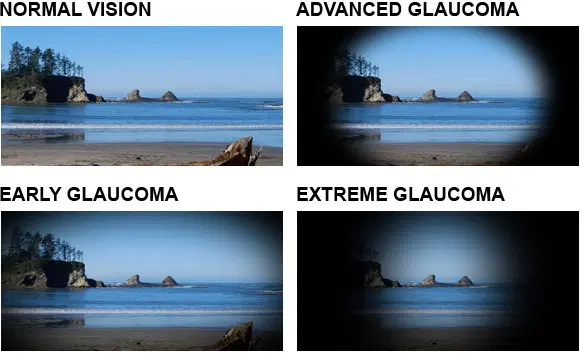Glaucoma is often a silent and painless disease of the optic nerve, which connects the eye to the brain and carries visual information. As the disease progresses you will slowly and often undectably lose your peripheral vision until you have significant vision loss. Glaucoma is often due to elevated eye pressure, but may also be related to certain medications, previous trauma/eye surgery, or even due to your eye’s unique anatomy.
Our Glaucoma Fellowship trained eye surgeons have been successfully treating glaucoma for years. Visit us today to help prevent irreversible vision loss due to glaucoma.

There are two major types of Glaucoma, Primary Open-Angle Glaucoma, and Angle-Closure Glaucoma (also known as Narrow-Angle glaucoma).
Primary Open-Angle Glaucoma is the most common type of glaucoma. It happens gradually, where the eye does not drain fluid as well as it should. As a result, eye pressure builds and starts to damage the optic nerve. This type of glaucoma is painless and causes no vision changes at first.
Angle-Closure Glaucoma happens when someone’;s irirs is very close to the drainage angle in their eye. The iris can end up blocking the drainage angle. You can think of it like a piece of paper sliding over a sink drain. When the drainage angle gets completely blocked, eye pressure rises very quickly. This is called an acute attack.
It is a true eye emergency, and you should call your ophthalmologist right away.
Signs of acute angle-closure glaucoma attack:
- Vision is suddenly blurry
- Severe Eye Pain
- Headache
- Sick to your stomach (nausea)
- You throw up
- You see rainbow-colored rings or halos around lights.
Many people with angle-closure glaucoma develop it slowly. This is called chronic angle-closure glaucoma. There are no symptoms at first, so they don’t know they have it until the damage is severe or they have an attack.
Symptoms
- Can Have Little to No Symptoms
- Eye Pain
- Decreased Vision
- Loss of Peripheral Vision

Glaucoma Treatment
Using the most advanced testing technology, we can closely monitor your glaucoma to maintain your vision. Often glaucoma can be treated with eye drops or laser surgery performed in our clinic.
The medication we can provide can lower eye pressure. Some do this by reducing the amount of aqueous fluid the eye makes. Others reduce pressure by helping fluid flow better through the drainage angle.
The laser surgery options our clinic offers are YAG Laser Peripheral Iridotomy, or YAG PI, and Trabeculoplasty, or SLT.
